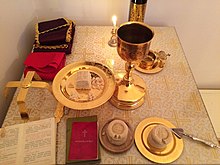Proscomidy
As Proskomidie is called in the Orthodox churches preparatory actions before the actual church service (the Eucharistic celebration in the form of the Divine Liturgy comparable held), the Offertory in the Western Church. The proscomidia symbolically refers to the incarnation of Jesus Christ, his birth, in which his death was already included. So there is both an incarnation and a passion symbolism .
historical development
The word προσκομηδή proskomēdḗ ( modern Greek pronunciation: proskomidí ) "offering" referred to the Eucharistic celebration as a whole in the ancient Church . In the Byzantine Middle Ages, the meaning narrowed to the armament of gifts. Originally that was the job of the deacons . Afterwards they only had to prepare the cup; the rest of the work became the task of the priests . The ritual cutting out of bread particles that are grouped around the " lamb " has been attested since the 11th century.
Eucharistic bread
In the northern corner of the sanctuary - that is, behind the iconostasis , not visible to the congregation - is the arming table ( prothesis ), where the bread used for the Eucharist is prepared. The Orthodox churches do not know unleavened hosts like the Western Church, but use wheat breads baked with yeast in the Eucharist, which are referred to as Prosphoren ( προσφορά prosphorá "sacrifice"). Before baking, the Greek letters ΙϹ ΧϹ ΝΙ ΚΑ ("Jesus Christ wins"), which are arranged in a square field around a cross, were stamped on the top of the bread with a bread stamp. Each bread consists of two flat loaves placed on top of one another, symbolizing the two natures of Christ .
In the Greek Orthodox Church there is a Prosphora which symbolizes the unity of Christianity. Not only the lamb is marked, but also the pieces that represent the Virgin Mary , the angels and the living and dead Christians. In the Russian and other Slavic Orthodox churches, however, five small loaves are used. These represent the five loaves from which 5000 people were fed according to Mk 6,39-44 EU . Such a Prosphora is about 5 cm wide and 4 cm high.
Separation of the "lamb"
Priests and deacons prepare for the celebration by praying, worshiping the icons , putting on the liturgical vestments and washing their hands. The following actions are accompanied by prayers and recitation of scriptures.
With the “lance” the priest cuts out the square middle section of the first Prosphora; this cube is called the "holy lamb". Then he cuts a larger piece out of the next Prosphora in the form of a pyramid in honor of the Blessed Mother . He then cuts out nine smaller pieces from the third Prosphora in honor of the angels, prophets, apostles, church fathers, martyrs and saints. Further pieces of bread are cut out of a Prosphora for the living and the deceased, which will be remembered during the service.
In the Greek tradition, these parts are marked on the edge of a large Prosphora. On the disc (bread bowl, corresponds to the western church paten ), all pieces of bread are arranged around the "lamb" in the center. This symbolically represents the fellowship of the whole church with Jesus Christ.
Further preparatory actions
- The wine, which must be made from red grapes, is mixed with a little water. On the one hand this follows the ancient custom of drinking wine only diluted, on the other hand it is supposed to symbolize the inseparable mixing of human and divine nature in Christ.
- The Eucharistic gifts are incensated , that is, they are smoked with incense .
- The disc is covered with the "star" ( asterisk ) on which a small blanket is placed. Another small blanket is placed on the chalice. A large blanket is spread over the chalice and the disc.
Individual evidence
- ↑ Cipria-Ioan Streza: liturgy, worship, songs . In: Ioan Vasile Leb, Konstantin Nikolakopoulos, Ilie Ursa (ed.): The Orthodox Church in Self-Presentation. A compendium. LIT Verlag, Berlin 2016. pp. 139–158, here p. 146.
- ^ A b Peter Plank: Proskomedie . In: Lexicon for Theology and Church , Volume 8, Herder, Freiburg / Basel / Vienna 1999, Sp. 644.
- ↑ a b Cipria-Ioan Streza: liturgy, worship, songs . In: Ioan Vasile Leb, Konstantin Nikolakopoulos, Ilie Ursa (ed.): The Orthodox Church in Self-Presentation. A compendium. LIT Verlag, Berlin 2016. pp. 139–158, here p. 148.
- ↑ Michael Kunzler : Prosphora . In: Lexicon for Theology and Church , Volume 8, Herder, Freiburg / Basel / Vienna 1999, Sp. 645.
- ↑ a b Eugen Hämmerle, Heinz Ohme, Klaus Schwarz: Approaches to Orthodoxy . Vandenhoeck & Ruprecht, 2nd ed. Göttingen 1989 (= Bensheimer Hefte No. 68), p. 46.
- ↑ Eugen Hämmerle, Heinz Ohme, Klaus Schwarz: Approaches to Orthodoxy . Vandenhoeck & Ruprecht, 2nd edition, Göttingen 1989 (= Bensheimer Hefte No. 68), p. 65.




